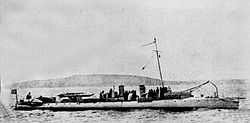- Ottoman torpedo boat Sultanhisar
-
For other ships of the same name, see TCG Sultanhisar.

Career (Turkey) 

Name: Sultanhisar Namesake: Sultanhisar Owner: Ottoman Navy, Turkish Navy Operator: 2nd Torpedo Boat Division Ordered: October 25, 1906 Builder: Schneider & Cie in Chalon-sur-Saône, France Laid down: 1906 Launched: 1907 Completed: 1907 Commissioned: 1907 Recommissioned: 1924 Decommissioned: 1928 Struck: 1935 General characteristics Type: Torpedo boat Displacement: 97 tons (full load)[1] Length: 40.2 m (132 ft)[1] Beam: 4.4 m (14 ft)[1] Draft: 1.9 m (6.2 ft)[1] Propulsion: Steam, 1 shaft. 2 Du Temple water tube, Schneider & Cie, 11.2t coal 1 triple expansion 3cyl., 2200ihp, Schneider & Cie[1] Speed: 26 knots (48 km/h) (trial), 16 knots (30 km/h) (1915)[1] Complement: 3 officers, 17-20 ratings (1907), 32 Ottomans, 4 Germans (1915)[1] Armament: 2x37mm (1.46 inch) QF H guns, 3xTT 450mm (18 in) SK torpedoes[1] Sultanhisar was a torpedo boat of the Ottoman Navy. She was built in 1907 by Schneider & Cie in Chalon-sur-Saône, France, and transferred the same year to Turkey.[1] She is best known for her action during the Gallipoli Campaign of World War I as she sank a Royal Australian Navy submarine in the Sea of Marmara and captured her crew.
Contents
Task
As of October 16, 1912, she was assigned to the Bosporus Fleet Command. From December 19, 1912 on, she served at the Armoured Warship Division.[1]
During the naval operations in the Dardanelles Campaign of World War I, the torpedo boat Sultanhisar was tasked with patrolling in the Dardanelles Strait. In addition, she daily transported German general Otto Liman von Sanders, who was the adviser and military commander of the Ottoman Army, between Eceabat and Gallipoli. On April 29, 1915, she received orders to return to Constantinople by sailing along the west coast of the Sea of Marmara. On the way, Commander Ali Rıza Bey changed his route and sailed eastwards in response to reports of the presence of a possible enemy submarine in that area.[2]
Attack on Australian submarine
The Australian submarine HMAS AE2 was able to pass through the blocked Dardanelles Strait and entered the Sea of Marmara on the early hours of April 25, 1915. She was the first Allied ship so to do.[3][4]
Sultanhisar sighted the submarine in the morning of April 30 in the Erdek Bay near Bandırma. The AE2 tried to escape by diving and surfacing several times. Torpedoes were exchanged between the two warships unsuccessfully. In the meantime, Sultanhisar called the Ottoman gunboats Zuhaf and Aydın Reis, which were patrolling in the area, for help. Finally, the submarine surfaced about 100 m (110 yd) from the torpedo boat. Sultanhisar opened fire and hit the submarine's engine room.[2][3][4]
Lieutenant Commander Henry Stoker scuttled the AE2 by opening all tanks and flooding his submarine, which was unable to maneuver. The crew abandoned the vessel, and she went down at 10:45. At this moment, the two Ottoman gunboats arrived at the scene and offered to rescue the submarine's crew, who had all survived the attack. Rejecting that offer, Commander Ali Rıza Bey took the 32 sailors on board and sailed back to Gallipoli.[3][4] After picking up two more POWs, one French and one British soldier, in Gallipoli, Sultanhisar headed for Istanbul.[2][5]
Aftermath
The Sultanhisar served until the end of the World War I and was decommissioned by the end of October 1918, after the Armistice of Mudros. Following the foundation of the Turkish Republic in 1923 in place of the dissolved Ottoman Empire, she returned in 1924 to service in the Turkish Navy. She was decommissioned in 1928 and was broken up in 1935.[1]
Namesakes
The name "Sultanhisar", a town in the Aydın Province of Aegean Region in Turkey, was given later to two other warships of the Turkish Navy:
- TCG Sultanhisar, a destroyer[6][7]
- TCG Sultanhisar (P-111) a patrol boat[8]
See also
- List of major surface ships of the Ottoman Steam Navy
- World War I naval ships of the Ottoman Empire
References
- ^ a b c d e f g h i j k Bernd Langensiepen, Ahmet Güleryüz, The Ottoman Steam Navy, 1828-1923, Naval Institute Press, Annapolis, Maryland, 1995, ISBN 1-55750-659-0, pp. 156-157.
- ^ a b c ""Sultanhisar" ve "AE2"" (in Turkish). Gallipoli-1915. http://www.gallipoli-1915.org/AE2.htm. Retrieved 2011-03-31.
- ^ a b c "British and Australian Submarines in the Dardanelles, 1915 - The AE2". ANZAC site. http://www.anzacsite.gov.au/5environment/submarines/ae2.html. Retrieved 2011-03-31.
- ^ a b c Dr. Chambers, Ian. "Lt Cdr Henry Stoker -- an Historic Journey. The AE2 and the Gallipoli Campaign". ANZAC Day Commemoration Committee (Qld) Incorporated. http://www.anzacday.org.au/history/ww1/anecdotes/ae2.html. Retrieved 2011-03-31.
- ^ Başarın, Vecihi and Hatice Başarin. Beneath the Dardanelles - The Australian Submarine at Gallipoli. ISBN 9781741755954. http://shop.abc.net.au/browse/product.asp?productid=539821.
- ^ Destroyers of World War Two, M. J. Whitley, 1988, Cassell Publishing ISBN 1-85409-521-8
- ^ British and Empire Warships of the Second World War, H. T. Lenton, Greenhill Books, ISBN 1-85367-277-7
- ^ "Refakat ve Karakol Filosu Komutanlığı" (in Turkish). Türk Deniz Kuvvetleri. http://www.dzkk.tsk.tr/turkce/birliktanitimi/RefakatveKarakolFilosuKomodorlugu.htm. Retrieved 2011-03-30.
Categories:- Ships built in France
- 1907 ships
- Ships of the Ottoman Navy
- World War I naval ships of the Ottoman Empire
- Torpedo boats of the Turkish Navy
- Gallipoli Campaign
Wikimedia Foundation. 2010.

